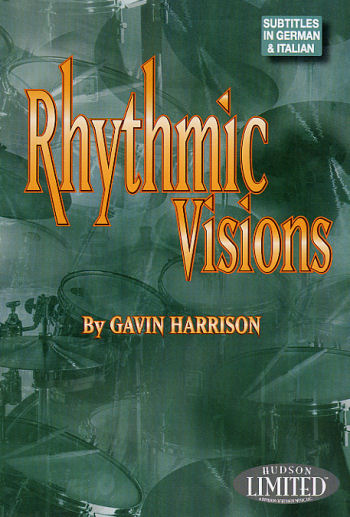
Gavin Harrison
Rhythmic Visions
DVD
Over the years Gavin Harrison, the drummer with Porcupine Tree since 2002, has written a series of highly acclaimed books and DVDs that are all concerned with creating illusions whether it's the illusion of creating a new downbeat or a new tempo, etc. Gavin has become widely known for taking metric modulations, polyrhythms, and rhythmically displaced grooves used by some of the world's greatest drummers and breaking them down into a series of easily understandable exercises. In the process, however, he has succeeded in creating concepts much farther advanced than their originators have ever imagined.
This time around, we're looking at Gavin's first DVD originally released in 2002, which has been newly released by the Hudson Limited division of Hudson Music, LLC.
Let's check it out.
Gavin Harrison's Visions: In-Depth
While most of the topics in this DVD are based on those from his first book Rhythmic Illusions,Gavin expands upon them and gives them more in-depth treatment to make them easier to learn here. Throughout the DVD you have two choices of audio tracks you can select from any time the "Alternate Audio" message appears on screen. The first audio track provides drums with a click and the alternate gives you drums in a musical setting. Also included are subtitles in German and Italian.
Rhythmic Visions is divided into four main sections, as follows:
Lessons: This section includes eight chapters consisting of exercises that you can use to create various types of rhythmic illusions.
Displacement 1 - Taking patterns and shifting them to a different place in time in the measure. Used with taste, this helps you to create tension during a performance.
Displacement 2 - Here Gavin demonstrates the use of displacements as a way to create new groove patterns.
Subdivisons - Gavin suggests the use of a metronome to practice the exercises in this section, which allow you to practice playing subdivisions - the notes that are played between the pulses, which Gavin considers the fundamental building blocks of everything that you'll ever play.
Spacings - Defined as the amount of subdivion that occurs between the bass drum acting as the downbeat and the snare drum as the backbeat, Gavin demonstrates various spacings including the common ones such as threes, fours, sixes, and eights, to the more uncommon types like fives, sevens, and nines.
Modulation 1 - Grouping the previously learn subdivision with various spacings, produces a modulation that provides the illusion that you're have shifted into a new tempo. In this first chapter on modulation Gavin uses the more common subdivisions of triplets, eighth- and sixteenth-notes, along with common spacings of three, four, six, and eight, to produce the illusion.
Modulation 2 - Gavin defines the second type of modulation as those that use common subdivisions of triplets, eighth- and sixteenth-notes, along with uncommon spacings such as fives and sevens. Type 2 modulations provide more excitement and tension but are more difficult to learn.
Modulation 3 - The third type of modulation is the coolest, and most complicated, and makes use of the uncommon subdivisions such as fives and sevens (quintuplets and septuplets) to create its illusion of a change in tempo when, in reality, no change in tempo has occurred.
Master Exercises - The previously covered spacings and subdivision chapter materials are now combined to form what Gavin calls his Master Modulation Exercise. This section includes a great explanation of Gavin's illusion concepts, which will help you understand exactly what makes the overall concepts of these Illusions work.
Tunes: This section consists of five musical selections performed by Gavin and made up of classic tunes as well as those composed by Gavin himself, during which he makes use of all of the previously covered Rhythmic Illusions.
Coda: This final major section of Rhythmic Visions consists of four chapters.
History - Gavin recalls the first time he heard a rhythmic illusion on a track recorded by the legendary studio drummer Steve Schaeffer.
Always There - Gavin discusses and demonstrates his use of a rhythmic illusion of changing tempo in a song he performed with the British funk band Incognito.
Rhythmic Journey - Gavin demonstrates further uses for rhythmic illusions, which incorporates the Rhumba Clave and double bass. This section of the DVD makes use of Gavin playing four separate rhythmic patterns shown on four parts of your screen, appearing and disappearing one by one, so you can clearly see and hear what's happening in each pattern. Very cool!
Harmonic Syncopation - This chapter continues the use of the previous four screen in one video technique as Gavin demonstrates more of his rhythmic illusions using opposing rhythms.
Play Shop Demo: This section consists of previously shown material from the DVD included together in one section for easy access and for practice purposes. It includes Gavin playing along to musical seclections and performing opposing rhythms, which show four separate performances together on one screen.
Rhythmic Visions: The Bottom Line
If you've heard about Gavin Harrison's groundbreaking concepts but have never ventured into his world, this
DVD is the perfect place to start. I highly recommend Rhythmic Visions for both intermediate and advanced players looking to expand
their existing skill set.
While a good value at its suggested retail price of $29.95, you will find it at a
discount online: Hudson Music Rhythmic Visions DVD by Gavin Harrison
Stay loose!
Tiger Bill

